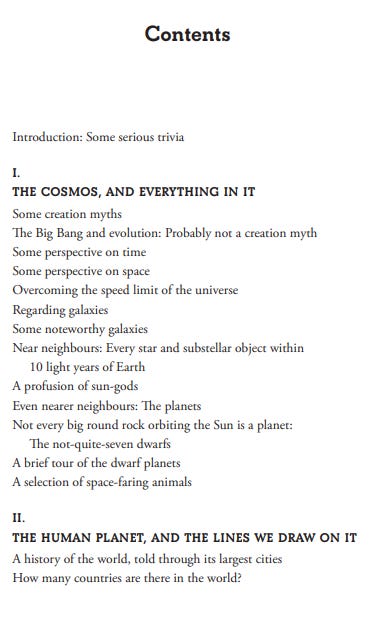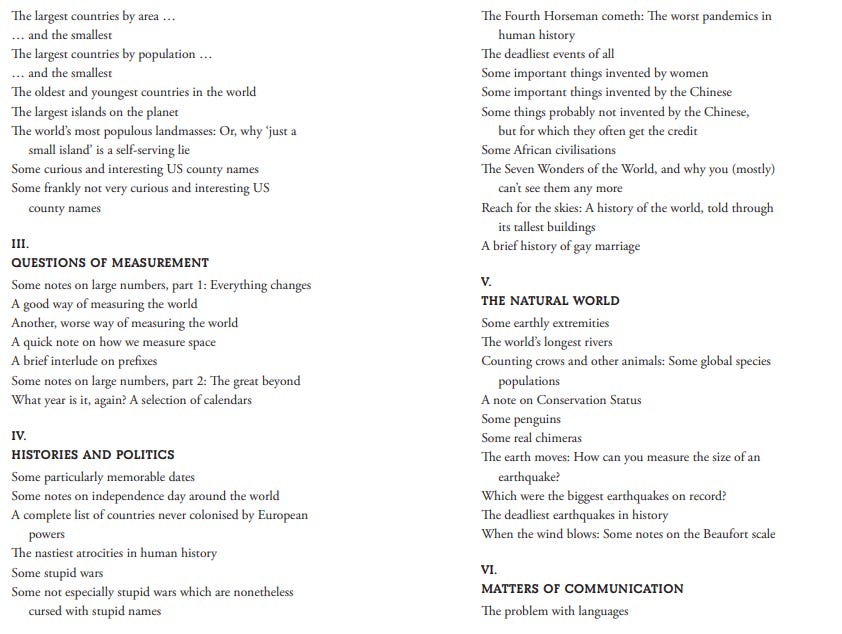It’s 16 December, so I’m assuming, by now, your chocolate advent calendar is already empty, the windows all carefully pushed back in to fool the rest of the family. (This may just be me.)
By this point you will also no doubt be worrying about what present to get someone in your life. But worry no longer! For I have just the thing:
And in case the cover art alone isn’t enough to convince you, here’s an extract.
Christmas is one of the most widely celebrated festivals on the planet, enjoyed both by Christians, who see it as honouring the birth of their Messiah, Jesus Christ, and non-Christians who live near them and/or were influenced by Western culture, who see it as a great excuse to eat too much, hug their loved ones and generally buy stuff.
But while most Christmas traditions involve giving gifts to children and lying about their origins, the exact identity of the being supposed to provide said presents varies wildly depending on where you are in the world. Here are some examples of the historical and/or mythical figure who gets the credit for parents’ hard work.
Santa Claus: In every sense The Big One. Grew out of traditions regarding St Nicholas, a 4th-century bishop in Myra, Turkey, who liked to give out gifts in secret. Popularised in North America thanks to the 1823 poem ‘A Visit from St Nicholas’, and thence, through the cultural imperialism of Hollywood, Coca-Cola adverts and the like, became the standardised image of the Christmas gift-giver throughout the world. Today, Helsinki airport styles itself as the official airport of Santa Claus, which is odd because as we’ll see the Finns have entirely different ideas of Christmas tradition; then again, the Santa myth has effectively eaten most of the others we’re going to come to.
Father Christmas: The traditional personification of Christmas in England: bearded, robed, with a crown of holly. Originally a symbol of adult feasting and merry-making, but as Christmas became more focused on children and families in the later 19th century, he became increasingly identified with Santa Claus, until today they’re effectively synonymous.
Père Noël/Papa Noël: Francophone version of same. Children leave their shoes by the fireplace stuffed with carrots and other treats for his donkey Gui (‘Mistletoe’); when they wake up, if they’ve been good, said carrots have been replaced by presents. This means that gifts have to be small enough to fit into a shoe, which obviously places a limit on the chances that Père Noël will bring you La PlayStation.
Sinterklaas: Another St Nick variant, this one popular in the Netherlands, Flemish-speaking Belgium and other Dutch-speaking places around the world. Arrives on a boat from Spain in mid-November, sporting a red bishop’s outfit and a long white beard, and rides a white horse. Also accompanied by Zwarte Piet (‘black Pete’), a helper dressed in what is euphemistically described as ‘Moorish attire’ and – there’s no easy way of saying this – blackface, which is presumably a lot more problematic now than it seemed a couple of centuries ago. Anyway: this one gives presents out on 5 December.
Christkind (‘Christ-child’): Martin Luther, the German theologian who kicked off the Reformation in 1517, promoted the idea that gifts were brought by baby Jesus himself, in a transparent attempt to ensure that everyone associated Christmas gifts with the actual Son of God. The idea spread from Protestant areas of Central Europe to Catholic ones in the 19th century, and from there to parts of Latin America. Christkind is the German name: elsewhere he’s known as Gesù Bambino (Italian), Menino Jesus (Portuguese: ‘Jesus Boy’), Ježíšek (Czech: ‘Little Jesus’), Niño Dios (Latin America: ‘God Child’) and so forth.
The Jólasveinar, or ‘Yule Lads’: The 13 prank-loving sons of Gryla, an Icelandic giantess who likes cooking and eating naughty children, and her lazy husband Leppaludi, who doesn’t leave their cave. The lads come to towns in Iceland one by one over the 13 nights before Christmas and leave presents in shoes left on windowsills. If the child has been naughty, they leave a potato instead, which one can only assume must symbolise the vegetables the child can expect to be cooked with in Gryla’s pot.
Grandfather Frost: The Russian equivalent of Santa Claus has his roots in pagan Slavic mythology. Dresses in a long fur coat, carries a magic staff, and unlike most equivalent figures is accompanied by a woman, his granddaughter the Snow Maiden, who wears silver-blue robes. They bring presents on the New Year’s holiday, which replaced Christmas during the anti-religion Soviet era.
Viejito Pascuero: Another version of Santa, who works in Chile, but the name literally translates as ‘Old Man Christmas’ so seems worth noting.
Saint Basil: Swings by homes in Greece and Cyprus on 1 January with gifts for the children. The 4th-century bishop of Caesarea, a Greek-speaking city in what is now Turkey, was known for his care of the poor and baked a pie with a gold coin in it.
The Christmas Gnome: The nisse is a diminutive, white-bearded mythological figure, who wears a red cap and looks a lot like a garden gnome. Since the mid-19th century, as Santa Claus became more popular worldwide, such gnomes have increasingly brought presents to the people of Scandinavia, displacing…
Julbocken/Joulupukki, the ‘Yule Goat’, whose beat is Finland and Sweden. Seems to have its origins in the pagan tradition that thunder god Thor’s chariot was drawn across the sky by a pair of goats. Once upon a time, the goat was scary and demanded you give it presents; then it was nice and gave them out; now it’s basically just Santa, but mystifyingly named after a goat.
While we’re talking about goats, though…
That cliffhanger points to the second of the book’s two Christmas-y entries, on the topic of the Gävle Goat. To read that, though, you’ll need to buy the book. And why not? It makes an excellent gift for the nerd/dad/curious child/random human being in your life.
So what else is in the book? Well I’m very glad you asked.
Why not order the book from Waterstones, Amazon or Foyles? Alternatively, why not…
But that’s enough of that. Here’s a picture of Henry Scampi being upset that the vet isn’t ready for him yet.








How did you manage to miss Caga Tio? The most bizarre of them all!
https://en.wikipedia.org/wiki/Ti%C3%B3_de_Nadal
6 Jan is the biggest day in Spain, when los Reyos Magos, the 3 Wise Men/Kings bring gifts.